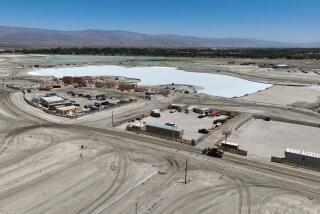Taylor Ranch Report Won’t Hurt School Plan, Cal State Officials Say
- Share via
The concerns raised in a recent report that assesses the environmental impact of a university campus on Taylor Ranch came as no surprise and do not pose any serious obstacles to building there, say California State University officials.
The report, which university officials were required to prepare if they are to condemn a portion of the west Ventura ranch, says development on the hillside property could congest city streets, add to air pollution, generate large amounts of solid waste and disturb an ancient Chumash Indian burial site.
Cal State officials, however, said they expected those issues to be raised by such a report and did not think it would be difficult to avoid most of the environmental harm.
“The report is quite substantial and thorough and to some people that might appear to be an obstacle to potential development,” said David Rosso, a planner for the university system. “But it isn’t any more serious than you would expect for a site like this. In the world of environmental impact reports, this one is fairly typical.”
Officials Agree
Ventura city officials, who would ultimately have to annex the unincorporated parcel, agreed.
“There’s some things in there that will have to be dealt with, but there would be with any property,” said Everett Millais, the city’s community development director. “I don’t think it means the prospects look bleak. We certainly weren’t alarmed.”
According to the report, which will be presented to the Cal State Board of Trustees for approval at a May 17 meeting, developing a university campus on a 465-acre parcel of the ranch to serve about 2,500 students would result in more traffic on the city’s downtown streets.
Although no new freeway ramps are planned, the report says a several-block-long portion of Main Street between Garden Street and the Ventura River would have to be widened to two lanes in each direction. In addition, more through-traffic lanes and left-turn lanes would have to be added to the intersection of Main Street and Ventura Avenue.
To reduce the campus’ effect on air pollution, the report calls for a car-pool program, as well as a campus post office, bank teller machines and a cafeteria. A recycling program should be initiated to help dispose of the nearly one ton of solid waste the campus would be expected to produce daily, the report says.
The report also says building crews must leave undisturbed some ancient Chumash burial grounds and a roost area for monarch butterflies--neither of which, say university officials, are close to the construction site.
Finally, a more detailed seismic study must be done for the ranch, which may sit on the Ventura Foothill fault as well as two other minor faults, the report says.
“That’s the purpose of an environmental impact report, to tell us about those issues,” Rosso said.
Cal State began its search more than three years ago for a Ventura County campus that would serve about 2,000 to 3,000 third- and fourth-year students. It has until July, 1990, to acquire a site, or lose about $8 million allotted for the project by the state Legislature.
The owners of Taylor Ranch, Santa Barbara residents Ailene B. Claeyssens and her daughter, Cynthia Wood, have refused to sell the property. But Cal State is taking steps, including preparation of the environmental impact report, that could allow them to purchase the property through eminent domain, a power granted to public agencies for acquiring private land for public purposes.
More to Read
Sign up for Essential California
The most important California stories and recommendations in your inbox every morning.
You may occasionally receive promotional content from the Los Angeles Times.













